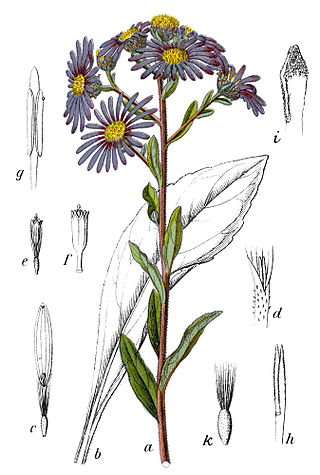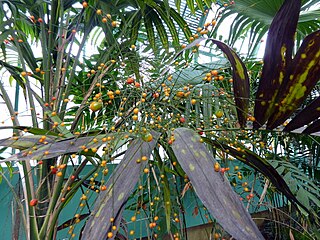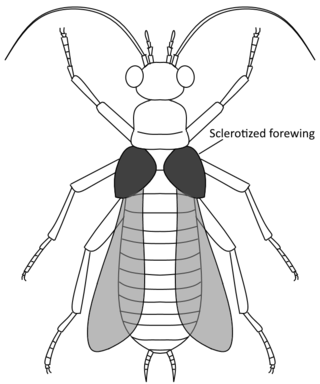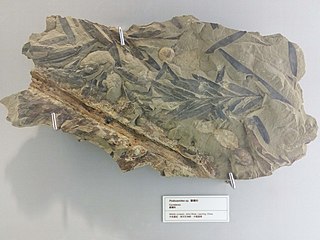
The Eurotiales are an order of sac fungi, also known as the green and blue molds. It was circumscribed in 1980.

The Trichocomaceae are a family of fungi in the order Eurotiales. Taxa are saprobes with aggressive colonization strategies, adaptable to extreme environmental conditions. Family members are cosmopolitan in distribution, ubiquitous in soil, and common associates of decaying plant and food material.

Bennettitales is an extinct order of seed plants that first appeared in the Permian period and became extinct in most areas toward the end of the Cretaceous. Bennettitales were amongst the most common seed plants of the Mesozoic, and had morphologies including shrub and cycad-like forms. The foliage of bennettitaleans is superficially nearly indistinguishable from that of cycads, but they are distinguished from cycads by their more complex flower-like reproductive organs, at least some of which were likely pollinated by insects.

Glaphyridae is a family of beetles, commonly known as bumble bee scarab beetles. There are eight extant genera with about 80 species distributed worldwide and two extinct genera described from the Aptian aged Yixian Formation of China. There are cases of flower-beetle interactions, in the southeast Mediterranean region between red bowl-shaped flowers and Glaphyridae beetles.

Asteroideae is a subfamily of the plant family Asteraceae. It contains about 70% of the species of the family. It consists of several tribes, including Astereae, Calenduleae, Eupatorieae, Gnaphalieae, Heliantheae, Senecioneae and Tageteae. Asteroideae contains plants found all over the world, many of which are shrubby. There are about 1,135 genera and 17,200 species within this subfamily; the largest genera by number of species are Helichrysum (500–600) and Artemisia (550).

Cycadeoidea is an extinct genus of bennettitalean plants known from the Cretaceous of North America, Europe and Asia. They grew as cycad-like plants with a short trunk topped with a crown of leaves.
Monanthesia is an extinct genus of bennettitalean plant that is known from fossil finds in Europe and North America, which existed during the Early Cretaceous period.
Areceae is a palm tree tribe in the family Arecaceae.

Chamaedoreeae is a palm tribe in the subfamily Arecoideae. It has five genera.

Alienopteridae is an extinct family of dictyopterans, known from the Mid-Cretaceous to Eocene. They are noted for their unusual combination of features not found in other dictyopterans.

Caelestiventus is a pterosaur genus from the Late Triassic found in western North America. The type species, Caelestiventus hanseni, honors Robin Hansen, the Bureau of Land Management geologist (BLM), who facilitated access to the excavation site.

Podozamites is an extinct genus of fossil conifer leaves. In its broader sense, it has been used as a morphogenus to refer to any broad leaved multi-veined conifer leaves. Modern broad-leaved conifers with a similar form include Agathis in the family Araucariaceae and Nageia in Podocarpaceae, with some Podozamitessensu lato probably belonging to the same families.

Pterophyllum is an extinct form genus of leaves known from the Carnian to the Maastrichtian, belonging to the Bennettitales. It contains more than 50 species, and is mainly found in Eurasia and North America.
Pelagodoxeae is a tribe of plants in the family Arecaceae found in Oceania, namely in New Guinea and the Marquesas Islands. The tribe has two monotypic genera, which are:

Otozamites is an extinct form genus of leaves belonging to the Bennettitales.
Nilssoniopteris is an extinct form genus of leaves belonging to the Bennettitales. Leaves are slender and often entire-margined (smooth-edged), though some species have dissected leaves with numerous small segments extending down to the rachis of the leaf. Nilssoniopteris-like leaves are distinguished by their syndetocheilic stomata, indicating bennettitalean affinities. Similar "taeniopterid" leaves are placed in the genus Nilssonia if their stomata are instead haplocheilic, or Taeniopteris if the cuticle is not preserved. Leaves of Nilssoniopteris vittata from the Middle Jurassic of England are associated with bisexual Williamsoniella reproductive structures.
Eoginkgoites is an extinct form genus of bennettitalean leaves from the Late Triassic of North America. Despite its palmate (hand-shaped) appearance similar to some early ginkgo species, it belongs to a different gymnosperm order, the Bennettitales. The leaf is deeply segmented into five to seven narrow, club-shaped lobes which twist around a very short rhachis. This leads to an overall fan-shaped leaf situated at the end of a long petiole. The leaf has paracytic stomata and veins which strongly branch and lead to a marginal vein at the edge of each leaflet. These structural traits are all shared with benettitaleans. Williamsonia carolinensis, an ovule-bearing bennettitalean cone, has been found closely associated with Eoginkgoites leaves, seemingly confirming its benettitalean identity.
Taeniopteris is an extinct form genus of Mesozoic vascular plant leaves, perhaps representing those of cycads, bennettitaleans, or marattialean ferns. The form genus is almost certainly a polyphyletic category for unfertile leaves of a certain shape ("taeniopterids") which cannot be assigned to specific groups due to a lack of information on cuticle or spore structures. The leaves are simple, with a strong central vein (rhachis) and an unbroken margin. The central vein leads to nearly perpendicular lateral veins, which may be slightly divided or undivided. The shape of the leaf is variable, but often elongated and smooth-edged. "Taeniopterid" leaves with bennettitalean-type cuticle are placed in the form genus Nilssoniopteris, while those with cycad-type cuticle are placed within Nilssonia and related genera. Some fertile "taeniopterids" preserve spore packages, and can be assigned to marattialean ferns.












